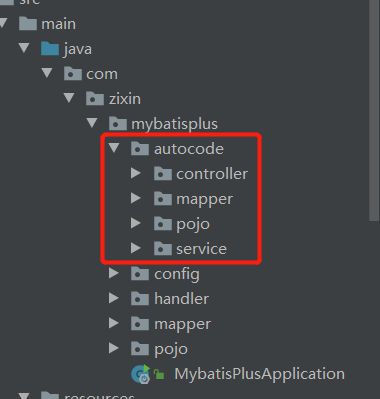MyBatisPlus
1.简介
- MyBatis-Plus (opens new window)(简称 MP)是一个 MyBatis (opens new window)的增强工具,在 MyBatis 的基础上只做增强不做改变,为简化开发、提高效率而生。
- 官网
2.特性
-
无侵入:只做增强不做改变,引入它不会对现有工程产生影响,如丝般顺滑
-
损耗小:启动即会自动注入基本 CURD,性能基本无损耗,直接面向对象操作
-
强大的 CRUD 操作:内置通用 Mapper、通用 Service,仅仅通过少量配置即可实现单表大部分 CRUD 操作,更有强大的条件构造器,满足各类使用需求
-
支持 Lambda 形式调用:通过 Lambda 表达式,方便的编写各类查询条件,无需再担心字段写错
-
支持主键自动生成:支持多达 4 种主键策略(内含分布式唯一 ID 生成器 - Sequence),可自由配置,完美解决主键问题
-
支持 ActiveRecord 模式:支持 ActiveRecord 形式调用,实体类只需继承 Model 类即可进行强大的 CRUD 操作
-
支持自定义全局通用操作:支持全局通用方法注入( Write once, use anywhere )
-
内置代码生成器:采用代码或者 Maven 插件可快速生成 Mapper 、 Model 、 Service 、 Controller 层代码,支持模板引擎,更有超多自定义配置等您来使用
-
内置分页插件:基于 MyBatis 物理分页,开发者无需关心具体操作,配置好插件之后,写分页等同于普通 List 查询
-
分页插件支持多种数据库:支持 MySQL、MariaDB、Oracle、DB2、H2、HSQL、SQLite、Postgre、SQLServer 等多种数据库
-
内置性能分析插件:可输出 SQL 语句以及其执行时间,建议开发测试时启用该功能,能快速揪出慢查询
-
内置全局拦截插件:提供全表 delete 、 update 操作智能分析阻断,也可自定义拦截规则,预防误操作
3.快速开始
-
创建数据库mybatis_plus
-
创建user表
DROP TABLE IF EXISTS user;
CREATE TABLE user
(
id BIGINT(20) NOT NULL COMMENT '主键ID',
name VARCHAR(30) NULL DEFAULT NULL COMMENT '姓名',
age INT(11) NULL DEFAULT NULL COMMENT '年龄',
email VARCHAR(50) NULL DEFAULT NULL COMMENT '邮箱',
PRIMARY KEY (id)
);
INSERT INTO user (id, name, age, email) VALUES
(1, 'Jone', 18, 'test1@baomidou.com'),
(2, 'Jack', 20, 'test2@baomidou.com'),
(3, 'Tom', 28, 'test3@baomidou.com'),
(4, 'Sandy', 21, 'test4@baomidou.com'),
(5, 'Billie', 24, 'test5@baomidou.com');
-
编写项目,使用 Spring Initializer初始化SpringBoot项目
-
导入依赖
<dependencies>
<dependency>
<groupId>org.springframework.boot</groupId>
<artifactId>spring-boot-starter-web</artifactId>
</dependency>
<dependency>
<groupId>org.springframework.boot</groupId>
<artifactId>spring-boot-starter-test</artifactId>
<scope>test</scope>
</dependency>
<!-- https://mvnrepository.com/artifact/mysql/mysql-connector-java -->
<dependency>
<groupId>mysql</groupId>
<artifactId>mysql-connector-java</artifactId>
</dependency>
<!--lombok-->
<!-- https://mvnrepository.com/artifact/org.projectlombok/lombok -->
<dependency>
<groupId>org.projectlombok</groupId>
<artifactId>lombok</artifactId>
</dependency>
<!--mybatis-plus-->
<dependency>
<groupId>com.baomidou</groupId>
<artifactId>mybatis-plus-boot-starter</artifactId>
<version>3.0.5</version>
</dependency>
</dependencies>
注意:不要同时注入mybatis和mybatis-plus的依赖
- 在配置文件中编写连接数据库信息,使用idea连接数据库
#数据库连接,mysql的把呢不能是5.7的
spring.datasource.driver-class-name=com.mysql.cj.jdbc.Driver
spring.datasource.url=jdbc:mysql://localhost:3306/mybatis_plus?characterEncoding=utf8
spring.datasource.username=root
spring.datasource.password=123456

- 编写User实体类
package com.zixin.mybatisplus.pojo;
import lombok.AllArgsConstructor;
import lombok.Data;
import lombok.NoArgsConstructor;
@Data
@NoArgsConstructor
@AllArgsConstructor
public class User {
private Long id;
private String name;
private Integer age;
private String email;
}
- 编写mapper接口
package com.zixin.mybatisplus.mapper;
import com.baomidou.mybatisplus.core.mapper.BaseMapper;
import com.zixin.mybatisplus.pojo.User;
import org.springframework.stereotype.Repository;
//在对应的Mapper上面继承基本的类
@Repository//代表持久层
public interface UserMapper extends BaseMapper<User> {
}
- 编写测试方法,运行得到结果
package com.zixin.mybatisplus;
import com.baomidou.mybatisplus.core.conditions.query.QueryWrapper;
import com.zixin.mybatisplus.mapper.UserMapper;
import com.zixin.mybatisplus.pojo.User;
import org.junit.jupiter.api.Test;
import org.springframework.beans.factory.annotation.Autowired;
import org.springframework.boot.test.context.SpringBootTest;
import java.util.List;
@SpringBootTest
class MybatisPlusApplicationTests {
//导入UserMapper
@Autowired
private UserMapper userMapper;
@Test
void contextLoads() {
}
/**
* 测试获取user列表数据
*/
@Test
void getUserListTest(){
List<User> userList = userMapper.selectList(new QueryWrapper<>());
userList.forEach(System.out::println);
}
}

4.配置日志
- 在application.properties中配置日志相关的配置
#配置日志
mybatis-plus.configuration.log-impl=org.apache.ibatis.logging.stdout.StdOutImpl
- 再次运行上面的
getUserListTest测试方法,可以看到控制台中SQL的详细信息
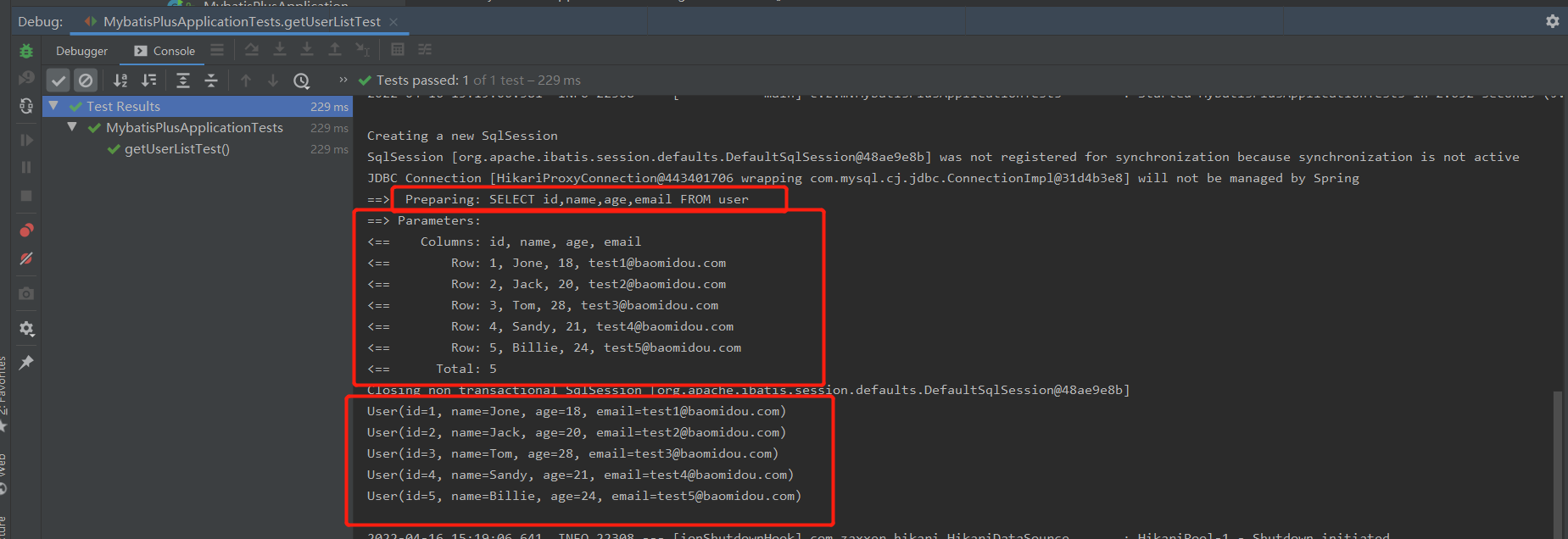
5.CRUD拓展
5.1插入测试与主键生成策略
- 插入测试
- 在测试类
MybatisPlusApplicationTests中编写一个插入用户信息的方法InsertUserTest如下所示:
//插入一条user记录,没有设置id
@Test
public void InsertUserTest(){
User user = new User();
user.setName("zixin");
user.setAge(20);
user.setEmail("3827653657@qq.com");
int row = userMapper.insert(user);
System.out.println(user);
System.out.println("受影响的行数:"+row);
}
- 运行
InsertUserTest测试方法,可以看到控制台中的插入SQL,id原本没有设置,插入的数据也有,还是一长串,这是数据库插入的全局的唯一的id

- 主键生成策略
-
默认ID_WORKER全局唯一id
-
雪花算法
- snowflake是Twitter开源的分布式ID生成算法,结果是一个long型的ID。
- 其核心思想是:使用41bit作为机器的ID(5个bit是数据中心,5个bit的机器ID),12bit作为毫秒内的流水号(意味着每个节点在每毫秒可以产生4096个ID),最后还有一个符号位,永远是0.可以保证几乎全球唯一
-
主键自增
-
修改user表中id的字段为自增

-
在User实体类中的Id字段上面添加
@TableId(type=IdType.AUTO)注解
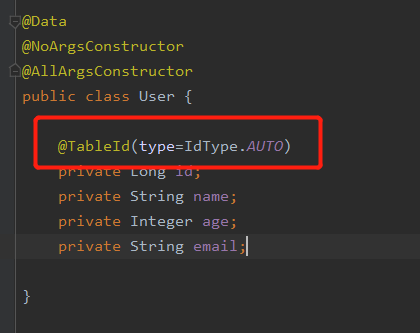
-
再次运行
InsertUserTest测试方法,可以看到数据库中新增加的一条数据的id是在上一条数据的id的基础上加一
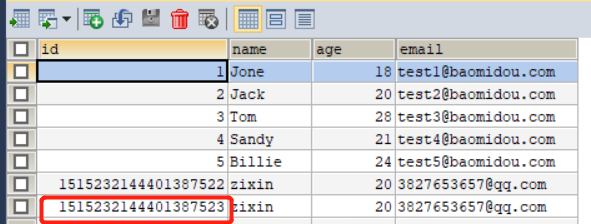
-
-
对
@TableId注解源码的分析
public enum IdType {
AUTO(0),//数据库id自增
NONE(1),//未设置主键
INPUT(2),//手动输入
ID_WORKER(3),//默认的全局唯一id
UUID(4),//全局唯一id uuid
ID_WORKER_STR(5);//ID_WORKER字符串表示法
}
5.2更新测试
- 在测试类
MybatisPlusApplicationTests中编写一个修改用户信息的方法updateUserTest如下所示:
//更新测试
@Test
public void updateUserTest(){
User user = new User();
user.setId(5L);
user.setName("芋头");
int row = userMapper.updateById(user);
System.out.println("更新的行数:"+row);
}
-
运行测试

-
在
updateUserTest方法中修改age字段,全部代码如下
//更新测试
@Test
public void updateUserTest(){
User user = new User();
user.setId(5L);
user.setName("芋头");
user.setAge(22);
int row = userMapper.updateById(user);
System.out.println("更新的行数:"+row);
}
- 运行测试

两次结果对比结论:SQL都是自动帮你动态配置的
5.3自动填充
- 方式一:数据库级别
-
在表中新增字段create_time,update_time

-
同步实体类中的字段
private Date createTime;
private Date updateTime;
- 测试
InsertUserTest方法,这里运行了两次,所以添加了两条数据

- 方式二:代码级别
-
删除数据库中create_time,update_time两个字段的默认值,并把非空的选项去掉

-
实体类create_time,update_time字段属性上添加注解
@TableField
//字段添加填充内容
@TableField(fill = FieldFill.INSERT)
private Date createTime;
@TableField(fill = FieldFill.INSERT_UPDATE)
private Date updateTime;
- 编写处理器来处理注解,在com.zixin.mybatisplus包下创建handler文件夹,并在该文件夹中创建MyMetaObjectHandler类,同时实现MetaObjectHandler接口
package com.zixin.mybatisplus.handler;
import com.baomidou.mybatisplus.core.handlers.MetaObjectHandler;
import lombok.extern.slf4j.Slf4j;
import org.apache.ibatis.reflection.MetaObject;
import org.springframework.stereotype.Component;
import java.util.Date;
@Slf4j
@Component
public class MyMetaObjectHandler implements MetaObjectHandler {
//插入时的填充策略
@Override
public void insertFill(MetaObject metaObject) {
log.info("-----------fill insert info------");
this.setFieldValByName("createTime", new Date(), metaObject);
this.setFieldValByName("updateTime", new Date(), metaObject);
}
//修改时的填充策略
@Override
public void updateFill(MetaObject metaObject) {
log.info("-----fill update info-------");
this.setFieldValByName("updateTime", new Date(), metaObject);
}
}
-
运行
insertUserTest方法,可以看到create_time,update_time这两个字段有按自定义的处理类来实现,这里可能不是很明显看出效果

-
运行
updateUserTest方法,可以明显看到update_time这个字段有按自定义的处理类来实现

5.4乐观锁
-
乐观锁和悲观锁的区别
-
乐观锁:总是认为不会出现问题,无论干什么不去上锁,如果出现了问题,再次更新值测试
-
悲观锁:总是认为总是出问题,无论干什么都会上锁,再去操作
-
-
乐观锁的实现方式
-
去除记录时,获取当前version
-
更新时,带上这个version
-
执行更新时,set version = newVersion where version = oldversion
-
-
测试MybatisPlus的乐观锁插件
-
给数据库中添加version字段

-
在User实体类中添加version字段
-
//乐观锁version注解
@Version
private Integer version;
- 注册插件
package com.zixin.mybatisplus.config;
import com.baomidou.mybatisplus.extension.plugins.OptimisticLockerInterceptor;
import org.mybatis.spring.annotation.MapperScan;
import org.springframework.context.annotation.Bean;
import org.springframework.context.annotation.Configuration;
import org.springframework.transaction.annotation.EnableTransactionManagement;
@MapperScan(basePackages = {"com.zixin.mybatisplus.mapper"})//扫描mapper类
@EnableTransactionManagement//开启事务
@Configuration//配置类
public class MybatisPlusConfig {
//注册乐观锁插件
@Bean
public OptimisticLockerInterceptor optimisticLockerInterceptor(){
return new OptimisticLockerInterceptor();
}
}
- 编写两个测试方法,分别是测试乐观锁成功和失败
//测试乐观锁成功
@Test
public void optimisticLockTest(){
//查询id为1d为1的用户信息
User user = userMapper.selectById(1L);
//修改用户信息
user.setName("乐观用户");
user.setAge(18);
//执行更新操作
int row = userMapper.updateById(user);
}
//测试乐观锁失败
@Test
public void optimisticLockTest2(){
//用户1
User user1 = userMapper.selectById(1L);
user1.setName("悲观用户1");
user1.setAge(12);
//用户2
User user2 = userMapper.selectById(1L);
user2.setName("悲观用户2");
user2.setAge(20);
//先修改用户2
userMapper.updateById(user2);
//再修改用户1
userMapper.updateById(user1);
}
-
运行
optimisticLockTest方法,可以看到id为1的用户version变为2

-
运行
optimisticLockTest2方法,可以看到id为1的用户version变为3,而不是4

5.5查询操作
- 在测试类
MybatisPlusApplicationTests中分别编写三个不同不同方式查询用户信息的测试方法,分别是getUserByIdTest、getUserByBatchId、getUserByMap如下
//根据id查询用户信息
@Test
public void getUserByIdTest(){
User user = userMapper.selectById(1L);
System.out.println(user);
}
//根据条件查询方式之一batch
@Test
public void getUserByBatchId(){
List<User> userList = userMapper.selectBatchIds(Arrays.asList(1, 2, 3));
userList.forEach(System.out::println);
}
//根据条件查询方式之一map
@Test
public void getUserByMap(){
Map<String, Object> map = new HashMap<>();
map.put("name","zixin");
List<User> userList = userMapper.selectByMap(map);
userList.forEach(System.out::println);
}
- 分别运行
getUserByIdTest、getUserByBatchId、getUserByMap方法,得到的结果分别如下



5.6分页查询
-
分页查询的方式
-
原始的limit进行分页
-
pageHelper第三方插件
-
MybatisPlus内置的分页插件
-
-
使用MybatisPlus内置的分页插件进行分页
- 在com.zixin.mybatisplus.config包下的MybatisPlusConfig配置类中配置拦截器组件
//分页插件 @Bean public PaginationInterceptor paginationInterceptor(){ return new PaginationInterceptor(); }- 在测试类中编写测试方法
//分页测试 @Test public void getUserByPageTest(){ //参数一:当前页;参数二:每页记录数 Page<User> userPage = new Page<>(1, 5); userMapper.selectPage(userPage, null); userPage.getRecords().forEach(System.out::println); System.out.println("总记录数:"+userPage.getTotal()); }- 运行测试方法
getUserByPageTest,得到的结果如下
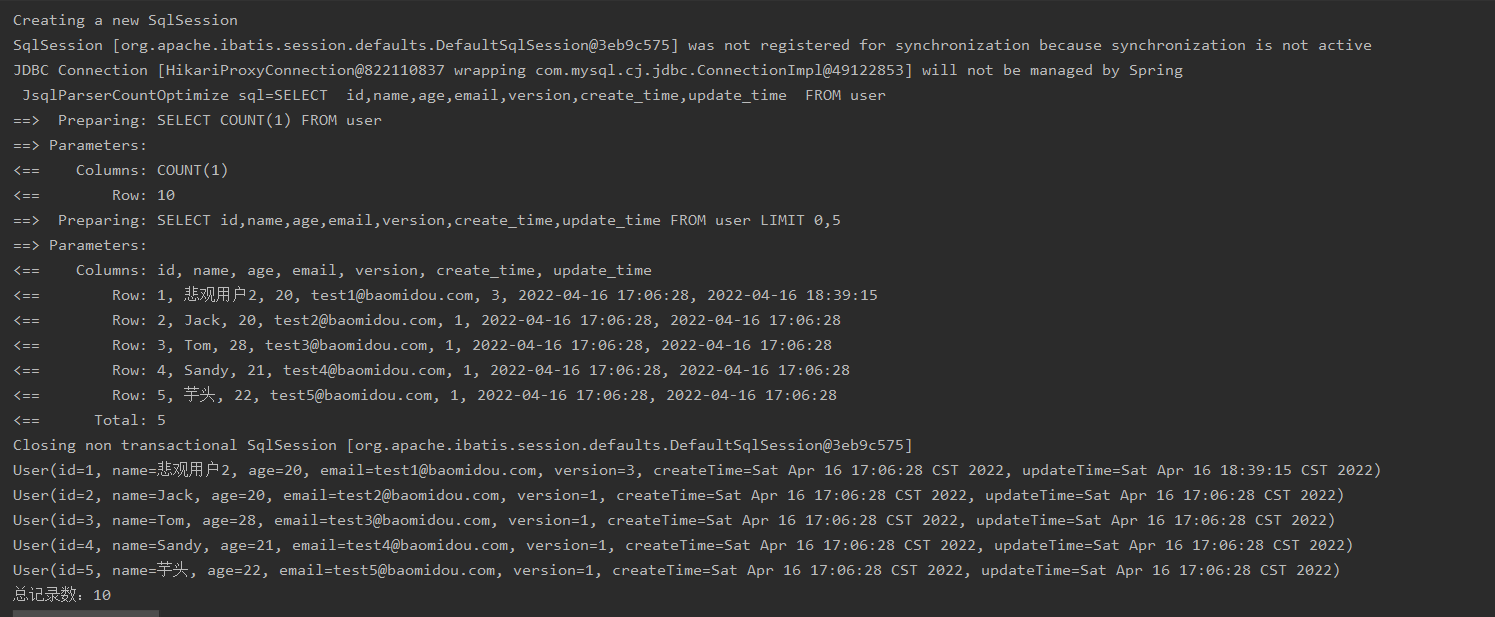
5.7删除操作
- 在测试类
MybatisPlusApplicationTests中编写三种方式删除用户信息的测试方法,分别为deleteUserByIdTest、deleteUserByBatchIdTest、deleteUserByMapTest
//根据id删除用户信息
@Test
public void deleteUserByIdTest(){
int row = userMapper.deleteById(1L);
System.out.println("删除的记录数:"+row);
}
//批量删除用户信息方式之一Batch
@Test
public void deleteUserByBatchIdTest(){
int rows = userMapper.deleteBatchIds(Arrays.asList(1515232144401387523L, 1515232144401387522L));
System.out.println("Batch方式删除的记录数:"+rows);
}
//批量删除用户信息方式之一Map
@Test
public void deleteUserByMapTest(){
Map<String, Object> map = new HashMap<>();
map.put("name", "zixin");
int rows = userMapper.deleteByMap(map);
System.out.println("Map方式删除的记录数:"+rows);
}
-
运行
deleteUserByIdTest方法,控制台与数据库中结果如下:


-
运行
deleteUserByBatchIdTest方法,控制台与数据库中结果如下:


-
运行
deleteUserByMapTest方法,控制台与数据库中结果如下:


5.8逻辑删除
-
物理删除与逻辑删除的区别
-
物理删除:从数据库中直接删除
-
逻辑删除:在数据库中没有被删除,而是通过一个变量来让它失效
-
-
测试
-
在数据表user中增加一个deleted字段,打开表,可以看到全部记录中的deleted字段值都为0


-
在User实体类中添加deleted属性
//逻辑删除 @TableLogic private Integer deleted;- 在配置类
MybatisPlusConfig中配置逻辑删除插件
//逻辑删除插件 @Bean public ISqlInjector iSqlInjector(){ return new LogicSqlInjector(); }- 在配置文件中配置逻辑删除的信息
#配置逻辑删除 mybatis-plus.global-config.db-config.logic-delete-value=1 mybatis-plus.global-config.db-config.logic-not-delete-value=0- 修改
deleteUserByIdTest测试方法中查询的id为2L,代码如下
//根据id删除用户信息 @Test public void deleteUserByIdTest(){ int row = userMapper.deleteById(2L); System.out.println("删除的记录数:"+row); }-
运行
deleteUserByIdTest测试方法,控制台和数据表中的结果如下


-
修改
getUserByIdTest测试方法中查询的id为2L,代码如下
//根据id查询用户信息 @Test public void getUserByIdTest(){ User user = userMapper.selectById(2L); System.out.println(user); }- 运行
getUserByIdTest测试方法,控制台结果如下,可以看到查询的记录为0,说明该数据不存在,而事实上是存在的,只是被逻辑删除了

-
6.性能分析插件
-
作用:性能分析拦截器,用于输出每条SQL语句及其执行时间
-
测试
- 在配置类
MybatisPlusConfig中配置性能分析插件
//SQL执行效率插件 @Bean @Profile({"dev","test"}) public PerformanceInterceptor performanceInterceptor(){ PerformanceInterceptor interceptor = new PerformanceInterceptor(); //设置SQL执行的最大时间,如果超过了就不执行,单位为ms interceptor.setMaxTime(10); //是否格式化代码 interceptor.setFormat(true); return interceptor; }- 在配置文件中配置环境为dev或test
#运行环境 spring.profiles.active=dev- 运行
getUserListTest测试方法,控制台报错,因为在配置性能分析插件是设置了sql的最大执行时间为10ms,而实际执行SQL的时间为17ms,超过了设置的时间
/** * 测试获取user列表数据 */ @Test void getUserListTest(){ List<User> userList = userMapper.selectList(new QueryWrapper<>()); userList.forEach(System.out::println); }
- 修改性能分析插件中sql的最大执行时间为20ms,再次运行
getUserListTest测试方法,可以获取到数据
interceptor.setMaxTime(20);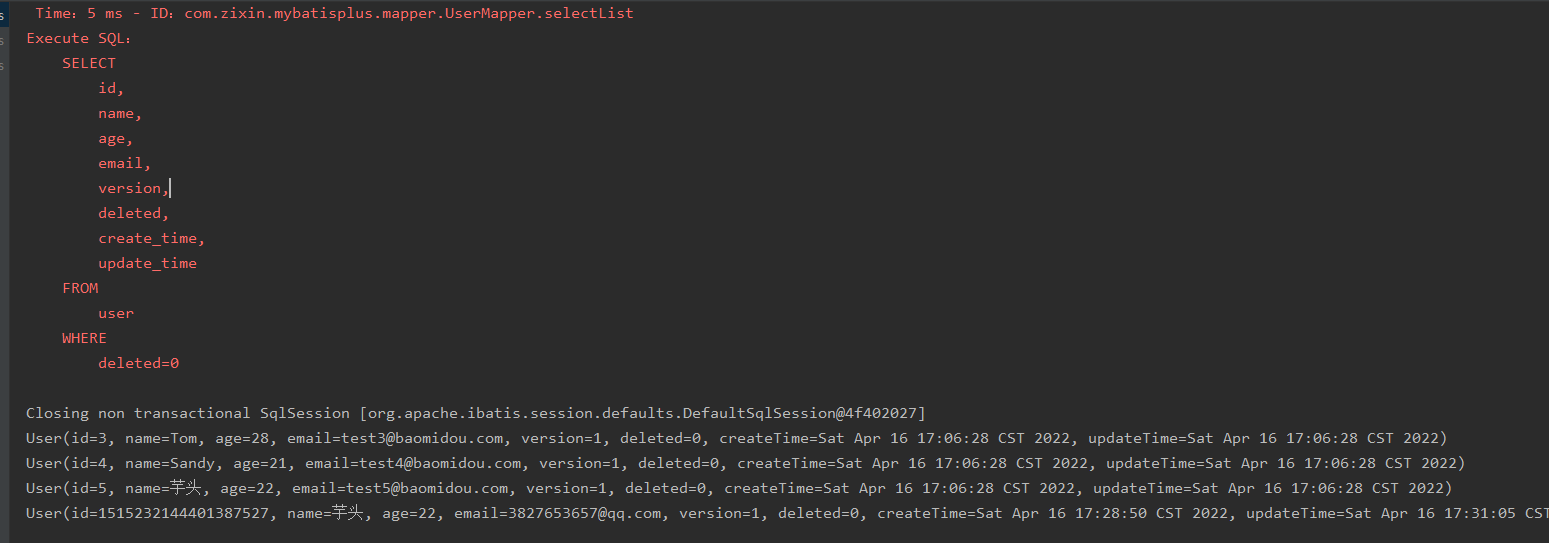
- 在配置类
7.条件查询器Wrapper
-
编写一个
WrapperTest测试类 -
编写
getUserTest1Test测试方法,查询name不为空,邮箱不为空且年龄大于22岁的用户,运行得到结果如下
@Test
public void getUserTest1Test(){
QueryWrapper<User> wrapper = new QueryWrapper<>();
wrapper.isNotNull("name")
.isNotNull("email")
.ge("age", 23);
List<User> userList = userMapper.selectList(wrapper);
userList.forEach(System.out::println);
}
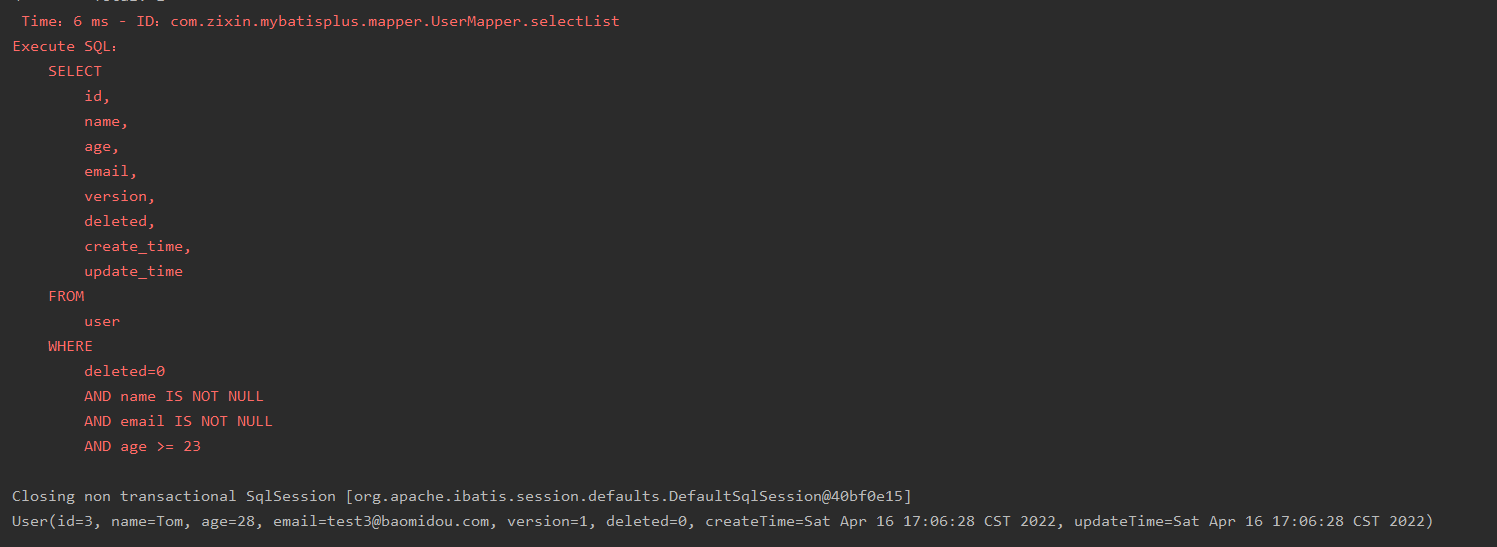
- 编写
getUserByNameTest测试方法,查询名字为”Sandy“的用户,运行得到结果如下
//查询名字为”Sandy“的用户
@Test
public void getUserByNameTest(){
QueryWrapper<User> wrapper = new QueryWrapper<>();
wrapper.eq("name", "Sandy");
User user = userMapper.selectOne(wrapper);//只有一条数据的前提下
System.out.println(user);
}
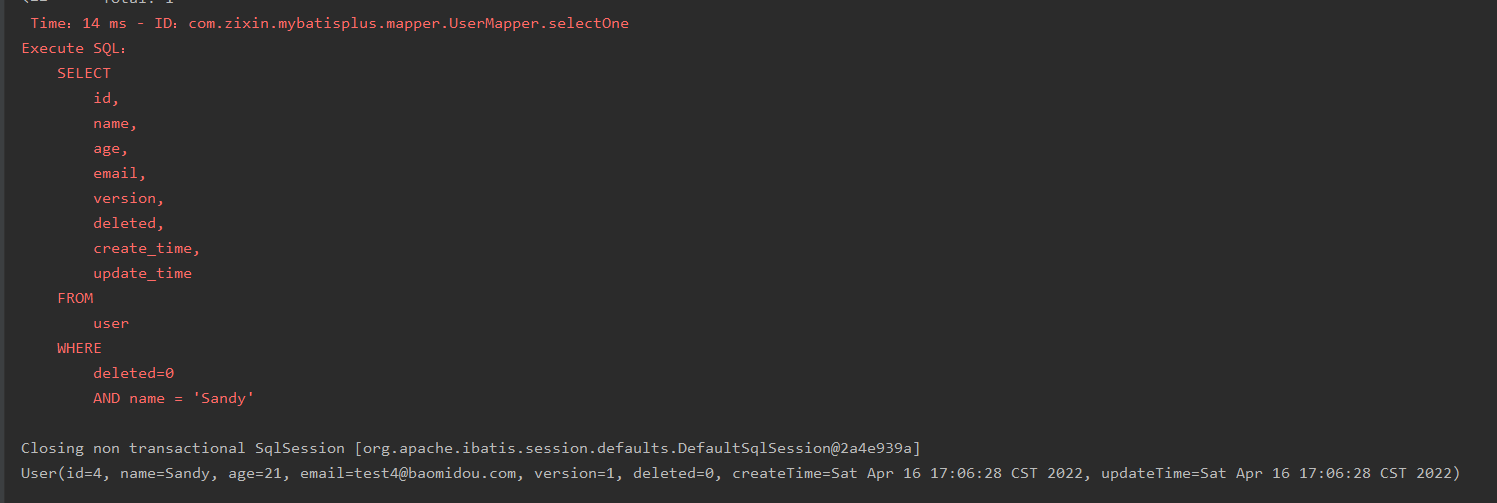
- 编写
getUserByAgeTest测试方法,查询年龄在20~25之间的用户,运行得到结果如下
//查询年龄在20~25之间的用户
@Test
public void getUserByAgeTest(){
QueryWrapper<User> wrapper = new QueryWrapper<>();
wrapper.between("age", 20, 25);
Integer count = userMapper.selectCount(wrapper);
System.out.println("用户数量为:"+count);
}

- 编写
getUserByLikeTest测试方法,模糊查询,查询name中不包含m,邮箱以t为开头的用户,运行得到结果如下
//模糊查询,查询name中不包含m,邮箱以t为开头的用户
@Test
public void getUserByLikeTest(){
QueryWrapper<User> wrapper = new QueryWrapper<>();
wrapper.notLike("name", "m")
.likeRight("email", "t");
List<Map<String, Object>> maps = userMapper.selectMaps(wrapper);
maps.forEach(System.out::println);
}
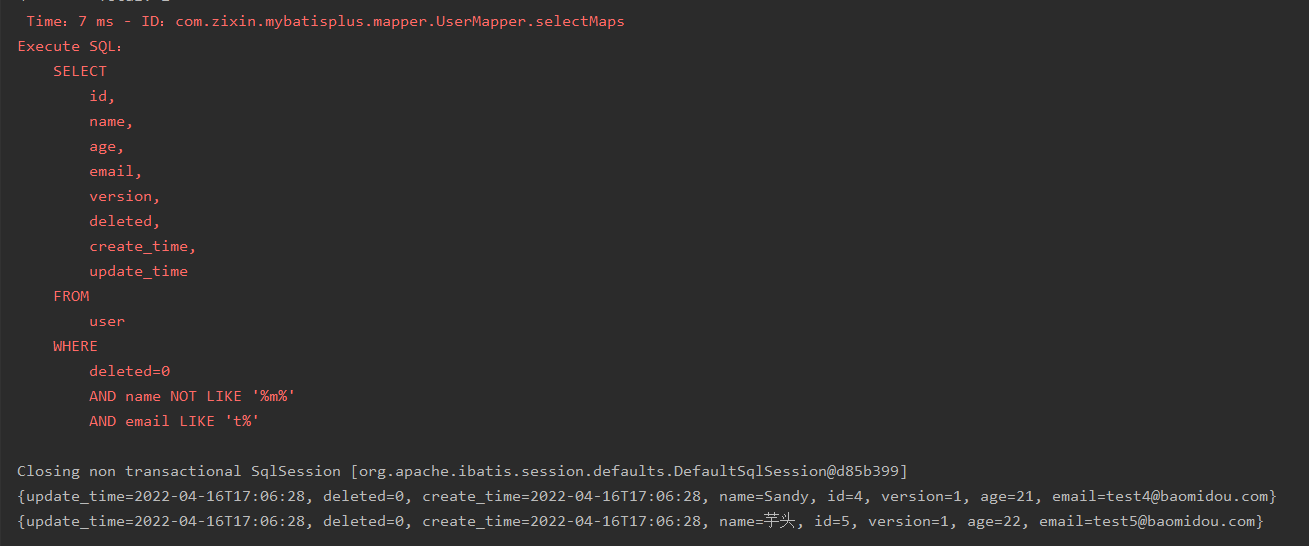
- 编写
getUserByIdTest测试方法,模糊查询,id在子查询中查询出来,运行得到结果如下
//模糊查询,id在子查询中查询出来
@Test
public void getUserByIdTest(){
QueryWrapper<User> wrapper = new QueryWrapper<>();
wrapper.inSql("id", "select id from user where id<19");
List<Object> objects = userMapper.selectObjs(wrapper);
objects.forEach(System.out::println);
}

- 编写
getUserByOrderTest测试方法,通过id进行降序排序,运行得到结果如下
//通过id进行排序
@Test
public void getUserByOrderTest(){
QueryWrapper<User> wrapper = new QueryWrapper<>();
wrapper.orderByDesc("id");
List<User> userList = userMapper.selectList(wrapper);
userList.forEach(System.out::println);
}
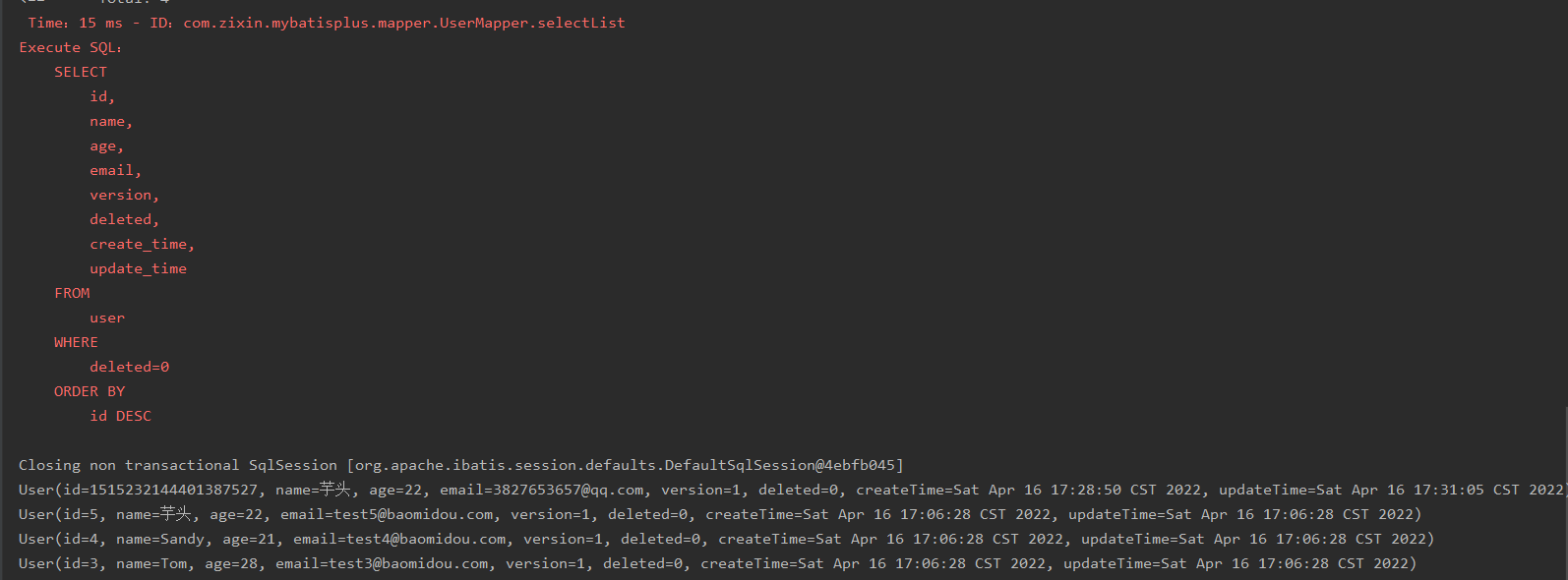
8.代码自动生成器
AutoGenerator是MyBatis-Plus的代码生成器,通过AutoGenerator可以快速生成 Entity、Mapper、Mapper XML、Service、Controller 等各个模块的代码,极大的提升了开发效率。
package com.zixin.mybatisplus;
import com.baomidou.mybatisplus.annotation.DbType;
import com.baomidou.mybatisplus.annotation.FieldFill;
import com.baomidou.mybatisplus.annotation.IdType;
import com.baomidou.mybatisplus.generator.AutoGenerator;
import com.baomidou.mybatisplus.generator.config.DataSourceConfig;
import com.baomidou.mybatisplus.generator.config.GlobalConfig;
import com.baomidou.mybatisplus.generator.config.PackageConfig;
import com.baomidou.mybatisplus.generator.config.StrategyConfig;
import com.baomidou.mybatisplus.generator.config.po.TableFill;
import com.baomidou.mybatisplus.generator.config.rules.DateType;
import com.baomidou.mybatisplus.generator.config.rules.NamingStrategy;
import java.util.ArrayList;
//代码自动生成器
public class zxCode {
public static void main(String[] args) {
//构建一个代码生成器对象
AutoGenerator ag = new AutoGenerator();
//配置策略
//1.全局配置
GlobalConfig gc = new GlobalConfig();
String projectPath = System.getProperty("user.dir");//获取系统路径
gc.setOutputDir(projectPath+"/src/main/java");//输出到那个目录
gc.setAuthor("zixin");//作者
gc.setOpen(false);//是否打开文件目录
gc.setFileOverride(false);//是否覆盖
gc.setServiceName("%sService");//去除Service的I前缀
gc.setIdType(IdType.ID_WORKER);//设置Id生成策略
gc.setDateType(DateType.ONLY_DATE);//设置日期的生成策略
gc.setSwagger2(true);//使用Swagger2
ag.setGlobalConfig(gc);
//2.设置数据源
DataSourceConfig dsc = new DataSourceConfig();
dsc.setUsername("root");//用户名
dsc.setPassword("123456");//密码
dsc.setUrl("jdbc:mysql://localhost:3306/mybatis_plus?characterEncoding=utf-8");//url
dsc.setDriverName("com.mysql.cj.jdbc.Driver");//驱动
dsc.setDbType(DbType.MYSQL);//数据库类型
ag.setDataSource(dsc);
//3.包的配置
PackageConfig pc = new PackageConfig();
pc.setModuleName("autocode");//生成的代码存放在那个模块
pc.setParent("com.zixin.mybatisplus");//父级包名
pc.setEntity("pojo");//实体类存放的包名
pc.setMapper("mapper");//mapper接口存放的包名
pc.setService("service");//service类存放的包名
pc.setController("controller");//controller类存放的包名
ag.setPackageInfo(pc);
//4.策略配置
StrategyConfig strategy = new StrategyConfig();
strategy.setInclude("user");//设置要映射的表名,只需改这里即可
strategy.setNaming(NamingStrategy.underline_to_camel);//设置表名下划线转驼峰命名
strategy.setColumnNaming(NamingStrategy.underline_to_camel);//设置字段名下划线转驼峰命名
strategy.setEntityLombokModel(true);//是否使用lombok开启注解
strategy.setLogicDeleteFieldName("deleted");//设置逻辑删除字段名称
//自动填充配置
TableFill createTime = new TableFill("createTime", FieldFill.INSERT);//设置创建日期自动填充策略
TableFill updateTime = new TableFill("updateTime", FieldFill.INSERT_UPDATE);//设置更新日期自动配置策略
ArrayList<TableFill> tableList = new ArrayList<>();
tableList.add(createTime);
tableList.add(updateTime);
strategy.setTableFillList(tableList);
//乐观锁配置
strategy.setVersionFieldName("version");
strategy.setRestControllerStyle(true);//开启驼峰命名
strategy.setControllerMappingHyphenStyle(true);//localhost:8080/aaa_id_2(controller类上面映射路径)
ag.setStrategy(strategy);
ag.execute();//执行
}
}
- 运行
zxCode自动生成代码类时,控制台出现下面错误

原因:缺少了依赖
解决方法:在pom.xml中加入velocity的依赖
<!-- 模板引擎 -->
<dependency>
<groupId>org.apache.velocity</groupId>
<artifactId>velocity-engine-core</artifactId>
<version>2.0</version>
</dependency>
- 再次运行,可以看到项目目录中有对应的代码,如下所示
